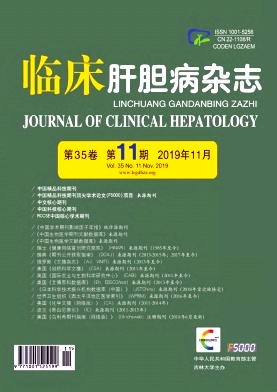|
[1] CHEN ZH. Problems and significance of liver allograft as an immunologically privileged organ[J]. Chin J Hepatol,2005,13(3):221.(in Chinese)陈忠华.同种肝脏移植免疫特惠器官现象及其临床意义[J].中华肝脏病杂志,2005,13(3):221.
|
|
[2] FISHMAN JA. Infection in solid-organ transplant recipients[J]. N Engl J Med,2007,357(25):2601-2614.
|
|
[3] KANEKU H,O'LEARY JG,TANIGUCHI M,et al. Donor-specific human leukocyte antigen antibodies of the immunoglobulin G3 subclass are associated with chronic rejection and graft loss after liver transplantation[J]. Liver Transpl,2012,18(8):984-992.
|
|
[4] ZHANG HM,LI SR,YU Y,et al. Bi-directional roles of IRF-1 on autophagy diminish its prognostic value as compared with Ki67 in liver transplantation for hepatocellular carcinoma[J].Oncotarget,2016,7(25):37979-37992.
|
|
[5] WANG Z,GONG W,SHOU D,et al. Clonal origin of hepatocellular carcinoma and recurrence after liver transplantation[J]. Ann Transplant,2016,21:484-490.
|
|
[6] WU D,ZHENG H,SHEN ZY,et al. Clinical significance of detection of the disseminating tumor cell before and during liver transplantation of HCC[J]. Chin J Organ Transplant,2007,28(4):217-219.(in Chinese)吴迪,郑虹,沈中阳,等.检测肝癌肝移植患者术前和术中肿瘤播散状况的临床意义[J].中华器官移植杂志,2007,28(4):217-219.
|
|
[7] LI JJ,JIANG WT,ZHENG H,et al. Tumor free technique in liver transplantation for liver cancer[J/CD]. Prac J Organ Transplant:Electronic Version,2017,5(4):266-267.(in Chinese)李俊杰,蒋文涛,郑虹,等.肝癌肝移植术中无瘤技术[J].实用器官移植电子杂志,2017,5(4):266-267.
|
|
[8] DELEON TT,SALOMAO MA,AQEL BA,et al. Pilot evaluation of PD-1 inhibition in metastatic cancer patients with a history of liver transplantation:The Mayo Clinic experience[J]. J Gastrointest Oncol,2018,9(6):1054-1062.
|
|
[9] JENSSEN T,HARTMANN A. Post-transplant diabetes mellitus in patients with solid organ transplants[J]. Nat Rev Endocrinol,2019,15(3):172-188.
|
|
[10] WANG H,JIANG W,ZHOU Z,et al. Liver transplantation in mainland china:The overview of CLTR 2011 annual scientific report[J]. Hepatobiliary surg Nutr,2013,2(4):188-197
|
|
[11] American Diabetes Association. Classification and diagnosis of diabetes:Standards of medical care in diabetes-2018[J]. Diabetes Care,2018,41(Suppl1):s13-s27.
|
|
[12] VAJDIC CM,van LEEUWEN MT. Cancer incidence and risk factors after solid organ transplantation[J]. Int J Cancer,2009,125(8):1747-1754.
|
|
[13] de MARTEL C,FERLAY J,FRANCESCHI S,et al. Gobal burden of cancers attributable to infections in 2008:A review and synthetic analysis[J]. Lancet Oncol,2012,13(6):607-615.
|
|
[14] ABERG F,PUKKALA E,HOCKERSTEDT K,et al. Risk of malignant neoplasms after liver transplantation:A populationbased study[J]. Liver Transpl,2008,14(10):1428-1436.
|
|
[15] van LEEUWEN MT,WEBSTER AC,MCCREDIE MR,et al.Effect of reduced immunosuppression after kidney transplant failure on risk of cancer:Population based retrospective cohort study[J]. BMJ,2010,340:c570.
|
|
[16] ZELLE DM,CORPELEIJN E,DEINUM J,et al. Parcreaticβ-cell dysfunction and risk of new-onset diabetes after kidney transplantation[J]. Diabetes Care,2013,36(7):1926-1932.
|
|
[17] MARTINEZ OM,KRAMS SM. The immune response to Epstein Barr Virus and implications for posttransplant lymphoproliferative disorder[J]. Transplantation,2017,101(9):2009-2016.
|
|
[18] KOTTON CN,HUPRIKAR S,KUMAR D. Transplant infectious diseases:A review of the scientific registry of transplant recipients published data[J]. Am J Transplant,2017,17(6):1439-1446.
|
|
[19] SWERDLOW SH,CAMPO E,PILERI SA,et al. The 2016 revision of the World Health Organization classification of lymphoid neoplasms[J]. Blood,2016,127(20):2375-2390.
|
|
[20] OSTENSEN AB,SANENGEN T,HOLTER E,et al. No effect of treatment with intravenous ganciclovir on Epstein-Barr virus viremia demonstrated after pediatric liver transplantation[J].Pediatr Transplant,2017,21(6):e13010.
|
|
[21] TRAPPE RU,DIERICKX D,ZIMMERMANN H,et al. Response to rituximab induction is a predictive marker in B-cell posttransplant lymphoproliferative disorder and allows successful stratification into rituximab or R-CHOP consolidation in an international,prospective,multicenter phase II trial[J]. J Clin Oncol,2017,35(5):536-543.
|
|
[22] HERRERO JI,PARDO F,D’AVOLA D,et al. Risk factors of lung,head and neck,esophageal,and kidney and urinary tract carcinomas after liver transplantation:The effect of smoking withdrawal[J]. Liver Transpl,2011,17(4):402-408.
|
|
[23] BACCARANI U,PISELLI P,SERRAINO D,et al. Comparison of de novo tumours after liver transplantation with incidence rates from Italian cancer registries[J]. Dig Liver Dis,2010,42:55-60.
|
|
[24] DENNY LA,FRANCESCHI S,de SANJOSES,et al. Human papillomavirus,human immunode ciency virus and immunosuppression[J]. Vaccine,2012,30(Suppl 5):f168-f174.
|
|
[25] MAGGI U,CONSONNI D,MANINI MA,et al. Early and late de novo tumors after liver transplantation in adults:The late onset of bladder tumors in men[J]. PLo S One,2013,8:e65238.
|
|
[26] LOWRANCE WT,ORDONEZ J,UDALTSOVA N,et al. CKD and the risk of incident cancer[J]. J Am Soc Nephrol,2014,25(10):2327-2334.
|
|
[27] MARTIN SI,DODSON B,WHEELER C,et al. Monitoring infection with Epstein-Barr virus among seromismatch adult renal transplant recipients[J]. Am J Transplant,2011,11(5):1058-1063.
|
|
[28] DANTAL J,CAMPONE M. Daunting but worthy goal:Reducing the de novo cancer incidence after transplantation[J].Transplantation,2016,100(12):2569-2583.
|
|
[29] FRANCOZ C,DURAND F,KAHN JA,et al. Hepatorenal syndrom[J]. Clin J Am Soc Nephrol,2019,14(5):774-781.
|







 DownLoad:
DownLoad: